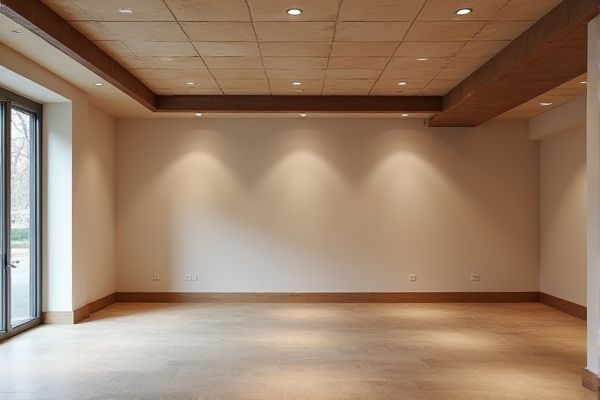
Painted ceilings offer a smooth, customizable finish that enhances the aesthetic appeal of your basement, while acoustical tiles provide superior sound absorption and noise control, making them ideal for entertainment spaces. Explore the full comparison to determine which ceiling option best suits your basement needs and personal style.
Table of Comparison
| Feature | Painted Ceiling | Acoustical Tiles Basement |
|---|---|---|
| Installation | Simple; paint applied directly to ceiling | Moderate; requires grid installation and tile placement |
| Cost | Lower; minimal materials needed | Higher; cost of tiles and grid system |
| Acoustic Performance | Low; no sound absorption | High; designed to reduce echo and noise |
| Maintenance | Easy; repaint as needed | Moderate; tiles can be replaced individually if damaged |
| Durability | Moderate; susceptible to moisture and staining | Good; moisture-resistant options available |
| Appearance | Sleek, seamless look | Textured, segmented look |
| Moisture Resistance | Poor; paint can peel in humid basements | Better; many tiles are mold and moisture resistant |
| Fire Resistance | Depends on paint type; generally low | Typically fire-rated tiles available |
Introduction to Basement Ceiling Options
Basement ceiling options typically include painted drywall or acoustical tiles, each offering distinct benefits for functionality and aesthetics. Painted ceilings provide a smooth, clean look that can seamlessly integrate with modern interiors, while acoustical tiles enhance sound absorption and allow easy access to plumbing and electrical systems. Your choice depends on whether you prioritize noise control and maintenance access or a sleek, uniform appearance in your basement space.
Overview of Painted Ceilings
Painted ceilings in basements offer a sleek and customizable finish that enhances the overall aesthetic while providing a smooth surface resistant to moisture and mold. This option allows for various color choices and design flexibility, making it ideal for modern or minimalist styles. Painted ceilings typically require less material cost compared to acoustical tiles but may lack sound absorption properties.
Overview of Acoustical Tile Ceilings
Acoustical tile ceilings in basements provide superior sound absorption and noise reduction compared to painted ceilings, making them ideal for creating quiet, functional spaces. These tiles typically feature porous materials that help dampen echoes and improve overall room acoustics, enhancing your basement's comfort and usability. Installation of acoustical tile ceilings also allows easy access to plumbing and electrical systems, offering practical maintenance benefits.
Aesthetics: Painted Ceilings vs. Acoustical Tiles
Painted ceilings offer a sleek, seamless look that enhances basement aesthetics by creating an open, modern atmosphere, while acoustical tiles provide a textured, grid-like appearance that can sometimes disrupt visual flow. The color and finish of painted ceilings can be customized to complement various design styles, whereas acoustical tiles primarily focus on functionality, offering limited design versatility. Choosing painted ceilings maximizes aesthetic appeal and design cohesion, whereas acoustical tiles prioritize sound absorption and practical use over visual impact.
Soundproofing and Acoustic Performance
Painted ceilings offer minimal soundproofing, as their hard surfaces tend to reflect sound waves, leading to increased noise levels and echo, which can negatively impact acoustic performance in basements. Acoustical tiles are specifically designed to absorb sound, reducing reverberation and improving overall noise control, making them significantly more effective for soundproofing in basement environments. Installing acoustical tiles not only enhances speech clarity and comfort but also minimizes sound transmission between rooms, providing a quieter and more acoustically balanced space.
Installation Process and Complexity
Installing a painted ceiling in a basement involves surface preparation, priming, and applying multiple paint layers, requiring careful attention to detail and drying times to achieve a smooth finish. Acoustical tiles offer a quicker installation process with pre-made panels mounted on a grid system, simplifying access to plumbing and wiring while providing sound absorption benefits. The complexity of painted ceilings lies in the detailed surface work, whereas acoustical tiles demand precise grid alignment and tile placement for optimal acoustic performance.
Maintenance and Durability Comparison
Painted ceilings in basements offer a smooth, seamless surface that is relatively easy to clean but may require frequent touch-ups due to susceptibility to moisture and stains. Acoustical tiles provide enhanced durability against humidity and can be easily replaced if damaged, reducing long-term maintenance costs. Their porous nature also contributes to improved sound absorption, making them a practical choice for noise control in basements.
Cost Considerations: Upfront and Long-Term
Painted ceilings in basements typically offer a lower upfront cost compared to acoustical tiles, as they require minimal materials and labor. Acoustical tiles involve higher initial expenses but provide sound absorption benefits that may reduce long-term costs related to noise control or soundproofing enhancements. Your choice should weigh immediate budget constraints against potential savings from improved acoustics and maintenance.
Customization and Design Flexibility
Painted ceilings offer extensive customization options with a wide palette of colors, patterns, and artistic designs that can be tailored to match any interior style or theme, enhancing visual appeal in basement spaces. Acoustical tiles provide design flexibility through various textures, shapes, and finishes that improve sound absorption while allowing integration of lighting and ventilation elements. Choosing between painted ceilings and acoustical tiles depends on balancing aesthetic goals with acoustic performance needs in basement remodeling projects.
Choosing the Best Ceiling for Your Basement
Choosing the best ceiling for your basement depends on factors like aesthetics, sound control, and maintenance. Painted ceilings offer a sleek, modern look and are cost-effective but provide minimal sound absorption, making them less ideal for noise reduction. Acoustical tiles enhance sound insulation, are easy to install, and allow access to plumbing or wiring, making them practical for basements where noise control and functionality are priorities.
 homyna.com
homyna.com